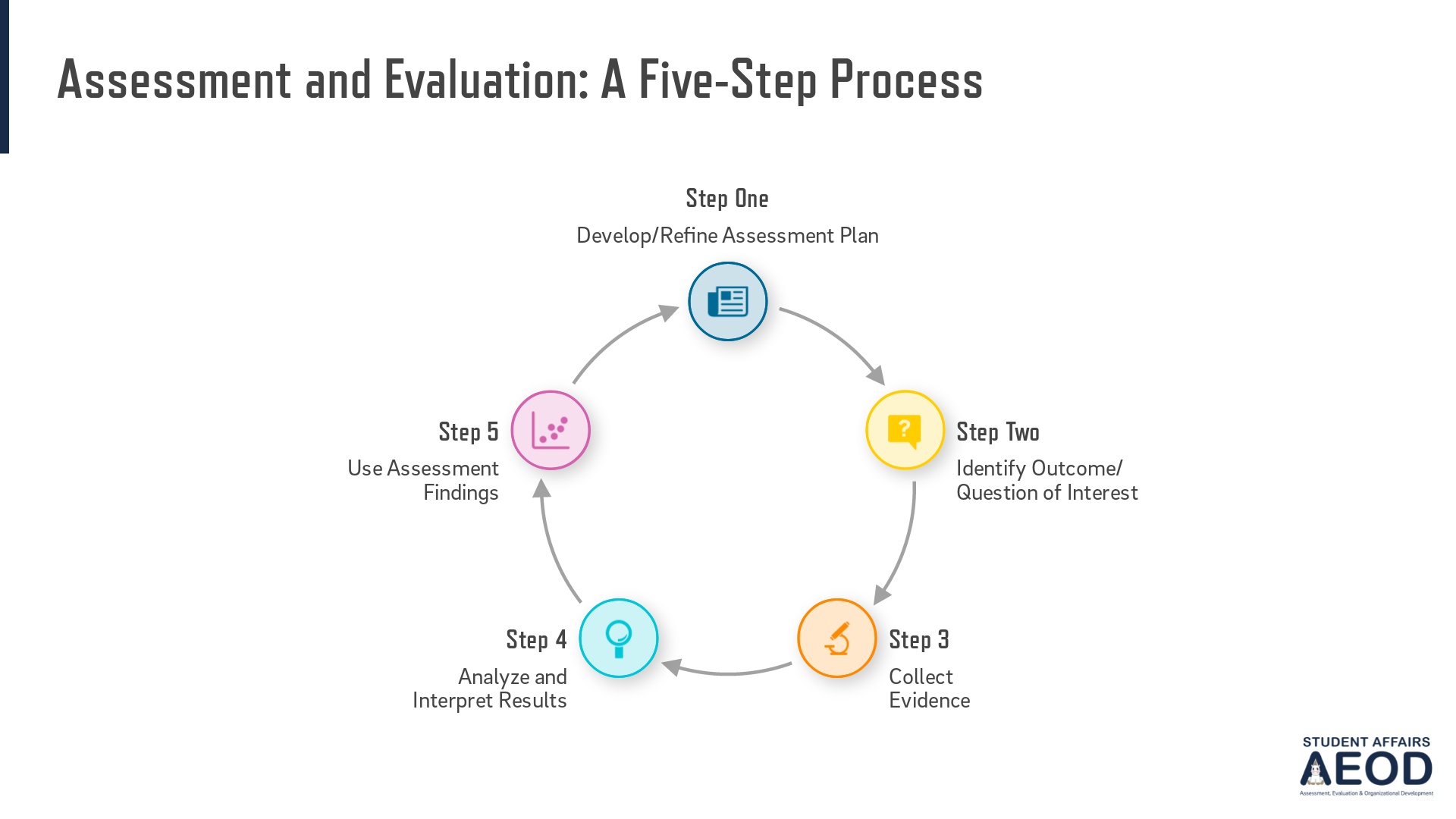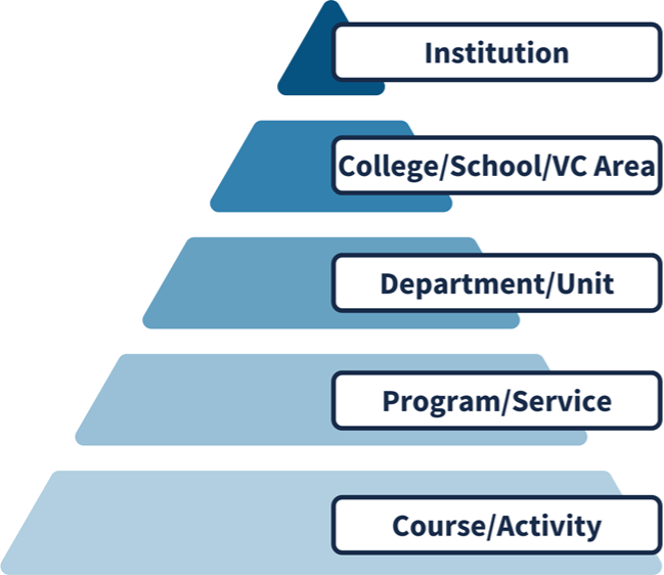Assessment Cycle

In Student Affairs and Campus Life, we consider assessment to be a five-step cycle. Each part of the cycle takes time and effort, and we've provided some resources to help you with this process.
Step 1: Develop/refine assessment plan
An important step when preparing for any assessment project is to develop an assessment plan. An assessment plan serves as a map of sorts, helping to identify where additional resources might be required and how to best use existing resources (including time). Assessment plans also help to ensure continuity of operations.
At minimum, an assessment plan should include information on:
☑︎ The anticipated timeline
☑︎ The purpose of the assessment
☑︎ Alignment with strategic priorities and initiatives, including Program/Department outcomes
☑︎ Who will be assessed
☑︎ How data will be collected, analyzed, and interpreted
☑︎ The anticipated audience(s) for the results
☑︎ An action plan to inform future decisions
The recommended assessment plan template for Student Affairs and Campus Life is available from AEOD.
Resources
Introduction to Assessment and Evaluation (PPTX)
Develop/Refine Assessment Plan (PPTX)
Step 2: Identify outcome/question of interest
Your outcomes or questions serve to communicate the intended purpose of your assessment. In this case, outcomes typically refer to “learning outcomes,” which are statements of what someone, often a student, should know, value, or be able to do after participating in your program or service. A non-exhaustive list of other types of outcomes includes “operational/program/process outcomes,” which focus more on what a program will do, or “affective,” which focus more on behaviors and attitudes.
Outcomes can be differentiated into levels, as shown below. Each of these levels of operation can and should have their own outcomes.

The pyramid helps to visualize both the granularity of outcomes in and the relationships between the levels. We’d expect outcomes at the activity level to be more granular, since they apply to only one activity. At the institution level, however, outcomes would be much broader, since they apply across programs and students. In addition, it’s common practice to use the results of assessments at the lower levels to provide evidence of outcome attainment at higher levels. For example, a program for student organizations may focus on conflict resolution skills that are particularly relevant for those orgs, but the results might roll up to support departmental outcomes around conflict resolution. This is also why it’s a good idea to ensure alignment of assessment to strategic priorities!
Identify Outcome/Question of Interest (PPTX)
Step 3: Collect evidence
Before starting to collect data be sure to check for whether the data already exists somewhere! A good resource for reviewing existing data is the AEOD data page. Not seeing what you are looking for? Contact AEOD or fill out the Data Request Form and we can help check!
Need to collect assessment data?
There are lots of different ways that assessment data can be collected, and it’s important to keep your outcomes, resources, and who you are assessing in mind when determining the best method to use.
The following are a few examples of common data collection methods:
Surveys
Surveys offer a relatively quick and easy way to gather both quantitative and qualitative data. UC San Diego offers survey platforms such as Qualtrics and Google Forms to faculty, staff, and students. If you need help with survey design both AEOD and Institutional Research (IR) are here to help!
A note about surveys: since they are easy to conduct they are very frequently used. Be mindful of other surveys that may be going on at the same time! AEOD generally recommends avoiding sending out a survey before the third week of enrollment and during final exam week, as engagement might be lower due to students’ courses.
Survey Resources
Writing Good Survey Questions: Tips and Advice (PDF)
Survey Response Options (PDF)
Focus Groups/Interviews
Focus groups and interviews are often used to collect qualitative data. They are typically more time-intensive than surveys, but often yield more in-depth responses.
A Good Reminder to End On!
When possible, the goal should be to use multiple sources of evidence when assessing outcomes. This is sometimes not realistic due to limited resources. However, it’s particularly worth striving for when assessment results will be used for high-stakes decision making.
Step 4: Analyze and interpret data
Analyzing data can often feel like the most daunting part of the assessment cycle, but there are lots of resources available to help with this!
Qualtrics
If you used Qualtrics to send a survey there are lots of built in data analysis tools, including:
Statistical analyses (including basic descriptive statistics, crosstabs, and inferential statistics)
- Thematic analysis
- Data visualizations, including tables, charts, and word clouds
- Zoom for Focus Groups and Interviews
If you are able to use Zoom to conduct focus groups and interviews this will take care of transcription for you, freeing up time to focus on double checking the transcription and conducting your analysis.
Other Tools
UC San Diego offers other tools that can be used for analysis, including those included with Microsoft and Google surveys and spreadsheets. Statistical analysis platforms such as MATLAB, SPSS, and STATA are also available for free through the university.
Collecting and Analyzing Quantitative Data (PPTX)
Collecting and Analyzing Qualitative Data (PPTX)
Step 5: Use assessment findings
Closing the Loop
The most important part of assessment is “closing the loop,” by which we mean using your assessment findings. Some questions to consider include:
- Based on your interpretation of results, what changes might need to be made to improve student learning of your intended outcomes, the student experience, etc?
- Am I making this a collaborative effort to ensure different perspectives and voices are represented in the recommendations?
- How am I celebrating positive results?
If there aren’t requirements in place about making changes during a certain period of time please note that it’s perfectly fine to opt to wait for more data in order to make a decision. That being said, if you feel like you are stuck while trying to make a decision feel free to reach out to AEOD! More often than not, you do have enough information to make at least some needed decisions.
Sharing Results
Part of using assessment findings includes sharing them out! One thing to consider is how sharing might look different for different audiences. For example, maybe an executive summary would be better for divisional leadership, but a social media post might be more appealing to students and alums. Whenever possible, include those who participated in the assessment in reviewing your findings before sharing them out!
There are plenty of free tools to help with sharing results, including Canva, Google Slides, and Microsoft PowerPoint.